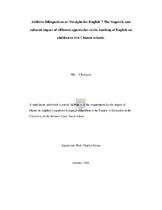| dc.contributor.advisor | Dyers, Charlyn | |
| dc.contributor.author | Chunyan, Ma | |
| dc.contributor.other | NULL | |
| dc.contributor.other | Faculty of Education | |
| dc.date.accessioned | 2013-05-28T09:22:48Z | |
| dc.date.available | 2007/03/22 12:09 | |
| dc.date.available | 2007/03/22 | |
| dc.date.available | 2013-05-28T09:22:48Z | |
| dc.date.issued | 2005 | |
| dc.identifier.uri | http://hdl.handle.net/11394/271 | |
| dc.description | Magister Educationis - MEd | en_US |
| dc.description.abstract | This study examines the impact of two different models of teaching English to Chinese children, to see whether it meets learners’ needs. These two different approaches appear to lead to different result for children. The results of the analysis appear to show that this teaching programme is failing the children at Z’SL. Therefore, the course needs to be reviewed and improved. Four research tools were used in this study: interviews, questionnaires, classroom observation, and document analysis. Interviews and questionnaires were distributed to coordinators and teachers at both schools. Questionnaires were also distributed to the parents of students. Classroom observation was done during normal class time by the researcher. The document analysis dealt with the analysis of the textbooks.
The results of the study appear to show that the teaching programme in English at Z’SL has failed to meet the children’s needs. The materials are not designed for young learner’s needs. They just emphasize the four skills of English in an English environment, but neglect the relatively unstable language situation of the children. The teaching methodology emphasized the direct method, but neglected children’s needs. Children should be taught to know how to use a language in the society they live in and to learn a second language effectively for actual use. This study concludes that two-way bilingual education and the cognitive developmental approach are most effective to develop dual language proficiency for Chinese children in their native language and English in order to bring up the children as members of Chinese society. Additive bilingualism education is also appropriate for Chinese children when the home language is a majority language and the school is adding a second minority or majority language. Another consideration is that collaboration between parents and teachers is more effective to provide opportunities for children to maintain their own language and culture while children acquire a second language | en_US |
| dc.language.iso | en | en_US |
| dc.publisher | University of the Western Cape | en_US |
| dc.subject | English language | en_US |
| dc.subject | Study and teaching | en_US |
| dc.subject | Chinese speakers | en_US |
| dc.subject | English language | en_US |
| dc.subject | Foreign speakers | en_US |
| dc.subject | Language and culture | en_US |
| dc.subject | China | en_US |
| dc.subject | Anthropological linguistics | en_US |
| dc.title | Additive Bilingualism or ‘Straight-for-English’? The linguistic and cultural impact of different approaches to the teaching of English on children in two Chinese schools | en_US |
| dc.type | Thesis | en_US |
| dc.rights.holder | University of the Western Cape | en_US |
| dc.description.country | South Africa | |

